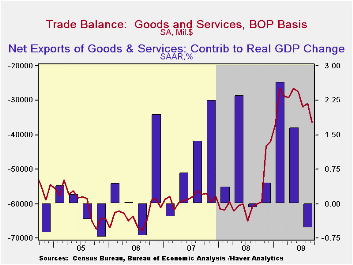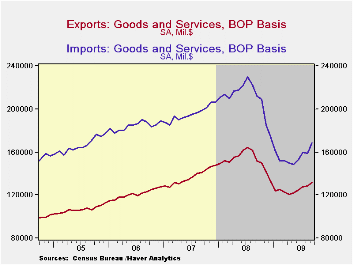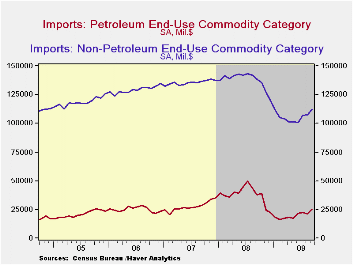 Global| Nov 13 2009
Global| Nov 13 2009U.S. Trade Deficit Increases Due To Higher Oil Costs, Improved Economy
by:Tom Moeller
|in:Economy in Brief
Summary
Following months of shrinkage due to lower oil prices and a poor economy, the September U.S. trade deficit widened significantly. The deficit of $36.5B followed a little-revised August figure of $30.8B and the m/m deterioration [...]
 Following
months of shrinkage due to lower oil prices and a poor economy, the
September U.S. trade deficit widened significantly. The deficit of
$36.5B followed a little-revised August figure of $30.8B and the m/m
deterioration greatly exceeded Consensus expectations for a deficit of
$31.6B. The latest figure was the deepest trade shortfall
since January. The rise in oil prices is evident in the trade deficit
figures adjusted for inflation. The m/m deterioration in the real
deficit was just under half that for nominal. However, offsetting that
was the improved economy which also lifted the inflation-adjusted
deficit as real imports jumped 6.2% m/m and by 10.1% over the last
three months.
Following
months of shrinkage due to lower oil prices and a poor economy, the
September U.S. trade deficit widened significantly. The deficit of
$36.5B followed a little-revised August figure of $30.8B and the m/m
deterioration greatly exceeded Consensus expectations for a deficit of
$31.6B. The latest figure was the deepest trade shortfall
since January. The rise in oil prices is evident in the trade deficit
figures adjusted for inflation. The m/m deterioration in the real
deficit was just under half that for nominal. However, offsetting that
was the improved economy which also lifted the inflation-adjusted
deficit as real imports jumped 6.2% m/m and by 10.1% over the last
three months.
 During September, petroleum imports jumped 20.9% after
having risen by over one-half since February. Higher prices prompted
that increase as crude oil costs rose to a September average of $68.17
per barrel versus the February low of $39.22. Since then crude oil has
risen even further to roughly $75 per barrel. The firmer economy raised
real imports of petroleum products by 6.9% during September and by 7.7%
over the last twelve months. That rise compares to declines of between
one and four percent during each of the last three years.
During September, petroleum imports jumped 20.9% after
having risen by over one-half since February. Higher prices prompted
that increase as crude oil costs rose to a September average of $68.17
per barrel versus the February low of $39.22. Since then crude oil has
risen even further to roughly $75 per barrel. The firmer economy raised
real imports of petroleum products by 6.9% during September and by 7.7%
over the last twelve months. That rise compares to declines of between
one and four percent during each of the last three years.
Economic recovery also was apparent in real nonoil imports which rose 4.2% during September and 11.3% during the last three months. These gains lessened the y/y decline to 14.8% from its worst of 24.6%. Real non-auto capital goods imports rose 2.5% (-18.9% y/y) and by 6.7% during the last three months. Real nonauto consumer goods rose 1.9% and 5.5% since June. Both of these increases are turnarounds from sharp declines through June. Real automotive vehicles & parts imports also turned higher by 11.4% (-12.1% y/y) in September and by nearly one-half since June. Despite the lower value of the dollar, economic recovery is further suggested by better travel figures. Imports of services have recently risen, with travel imports strong during three of the last four months as more U.S. residents went abroad.
 Reflecting the competitive value of the dollar, real
merchandise exports during September rose 4.4% (-9.5% y/y) following
three months of 7.0% increase. That's a turnaround from 20% rates of
decline this summer. The chained dollar value of real capital goods
exports led the September increase with a 5.2% gain (-14.3% y/y) which
reversed an August drop. Non-auto consumer goods exports also rose 3.6%
and the y/y decline eased to 5.6% from the peak of -15.7%. Auto exports
were strong for the fourth straight month and the y/y decline of 26.2%
was half its worst reading. Exports of services also have been strong
of late.
Reflecting the competitive value of the dollar, real
merchandise exports during September rose 4.4% (-9.5% y/y) following
three months of 7.0% increase. That's a turnaround from 20% rates of
decline this summer. The chained dollar value of real capital goods
exports led the September increase with a 5.2% gain (-14.3% y/y) which
reversed an August drop. Non-auto consumer goods exports also rose 3.6%
and the y/y decline eased to 5.6% from the peak of -15.7%. Auto exports
were strong for the fourth straight month and the y/y decline of 26.2%
was half its worst reading. Exports of services also have been strong
of late.
The international trade data can be found in Haver's USECON database. Detailed figures are available in the USINT database.
Trade, Globalization and the Financial Crisis from the Federal Reserve Bank of Dallas is available here.
| Foreign Trade | September | August | July | Y/Y | 2008 | 2007 | 2006 |
|---|---|---|---|---|---|---|---|
| U.S. Trade Deficit | $-36.5 | $30.8B | $31.9B | $60.1B (9/08) | $695.9 | $701.4 | $760.4 |
| Exports - Goods & Services | 2.9 | 0.2% | 2.5% | -13.2% | 11.2% | 13.2% | 13.3% |
| Imports - Goods & Services | 5.8 | -0.4% | 4.9% | -20.6% | 7.6 | 6.0% | 10.8% |
| Petroleum | 20.9 | -5.4% | 3.3% | -31.9% | 37.0% | 9.4% | 20.1% |
| Nonpetroleum Goods | 4.4 | 0.3% | 6.4% | -19.2% | 1.5% | 4.8% | 9.1% |
Tom Moeller
AuthorMore in Author Profile »Prior to joining Haver Analytics in 2000, Mr. Moeller worked as the Economist at Chancellor Capital Management from 1985 to 1999. There, he developed comprehensive economic forecasts and interpreted economic data for equity and fixed income portfolio managers. Also at Chancellor, Mr. Moeller worked as an equity analyst and was responsible for researching and rating companies in the economically sensitive automobile and housing industries for investment in Chancellor’s equity portfolio. Prior to joining Chancellor, Mr. Moeller was an Economist at Citibank from 1979 to 1984. He also analyzed pricing behavior in the metals industry for the Council on Wage and Price Stability in Washington, D.C. In 1999, Mr. Moeller received the award for most accurate forecast from the Forecasters' Club of New York. From 1990 to 1992 he was President of the New York Association for Business Economists. Mr. Moeller earned an M.B.A. in Finance from Fordham University, where he graduated in 1987. He holds a Bachelor of Arts in Economics from George Washington University.






